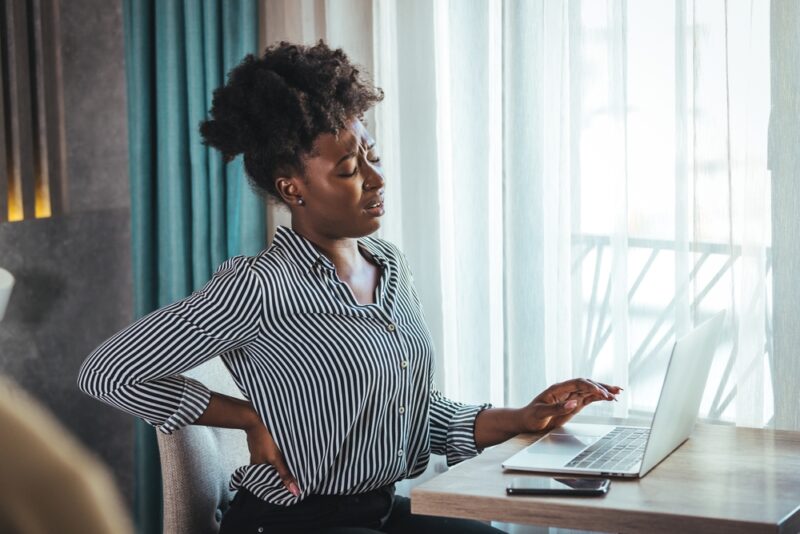There are many potential causes of a stiff back, and knowing a short list of possible causes for a stiff back can help you have a more productive and in-depth conversation with your doctor. Continue reading to understand the 4 causes of a stiff back and how Comprehensive Spine Care can help you prevent them.
1. Tight Thigh and Hip |Muscles
Tightness in certain muscle groups in the thighs and/or hips can alter the biomechanics of the spine. Common examples are:
- Tight hamstrings: Your hamstring muscles run through the back of each thigh. This large, powerful muscle group can become tight for several reasons, including lack of exercise or lack of stretching before and after exercise. When your hamstrings are tight, they shorten. These changes affect the curvature of the lower spine and disrupt the alignment of the spine with the pelvis (hips). As a result, you may experience stiffness in your lower back, with or without pain. Stiffness is often more noticeable when you bend your spine forward.
Prevention tip: Targeted hamstring stretches can gradually lengthen the hamstrings and relieve lower back stiffness.
- Tight Hip Flexors: Hip flexion happens when the iliopsoas muscles in your hip allow you to lift your thigh and bring it closer to your body. Tightness in the iliopsoas can cause stiffness in the spinal segment. Severe iliopsoas narrowing can cause spinal instability. The surrounding spinal tissue may also become inflamed and irritated, causing pain.
Prevention tip: Stress on the spine can be relieved with stretches that help lengthen the hip flexors.
2. Sitting With Your Spine Leaning Foward
When you sit for a long time, the following changes happen to your spine:
- Pressure increases within each spinal segment
- Less strength in the muscles of your lower and upper back
- Reduced nutrient supply to spinal tissues
- Sitting on the edge of a chair or leaning against a computer puts more stress on the spine and can lead to stiffness and pain.
Prevention tip: To avoid a stiff back, sit up straight. Roll your shoulders back so your ears are over your shoulders and your upper arms are parallel to your torso.
3. Inflammatory Changes In The Spine
Inflammation can cause joints in the spine to become immobile and/or fuse, resulting in stiffness. Two common examples are:
- Ankylosing spondylitis: When inflammation in the spine causes adjacent vertebrae to gradually fuse together, it’s called ankylosing spondylitis. This condition causes progressive stiffness and chronic upper and/or lower back pain.
Prevention tip: Stiffness usually improves with exercise, not with rest.
- Osteoarthritis: Osteoarthritis is the breakdown of the protective cartilage between the small joints in the back of the spine. As a result, your joints create more friction when you move, which can lead to pain and stiffness.
- Stiffness usually occurs in the morning, lessens with exercise throughout the day, and peaks again after prolonged periods of inactivity or rest.
- Ankylosing spondylitis and spinal osteoarthritis can be managed with medication, exercise, and lifestyle changes.
4. Disc Dehydration and Shrinkage
Intervertebral discs are the shock-absorbing cushions between the vertebrae that distribute loads within the spine. When a disc degenerates, its fibrocartilage components break down, lose water and lose height. These changes can cause stiffness in the spine, especially when flexed. Treatment usually includes physical therapy, exercise, medication, and weight loss. Surgery is always used as a last resort.
Comprehensive Spine Care is comprised of board-certified orthopedic spine surgeons with expertise in all aspects of spine care, including degenerative disc disease, sports and work-related spinal injuries, scoliosis, oncology surgery, minimally invasive surgery, and Cervical disc replacement. Call 201-634-1811 to book an appointment.










